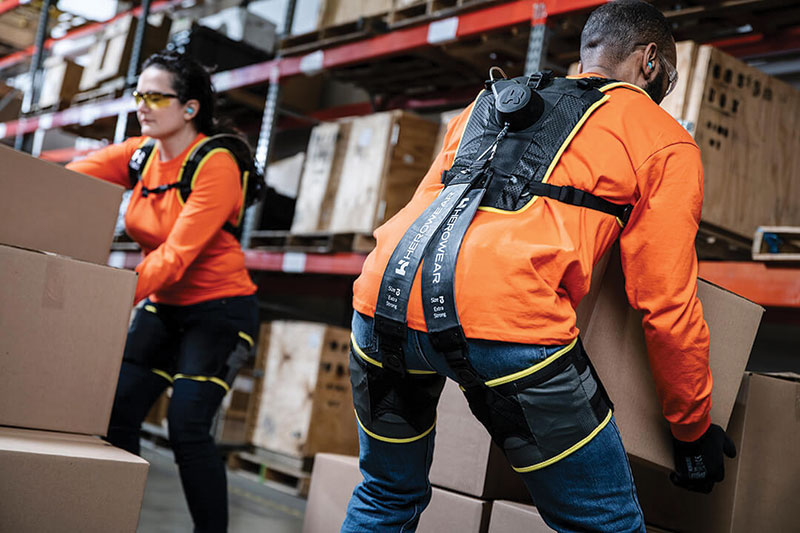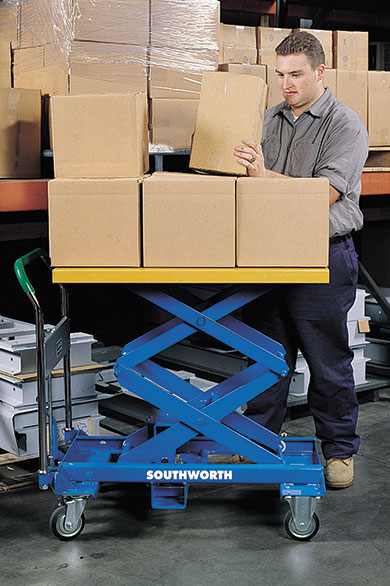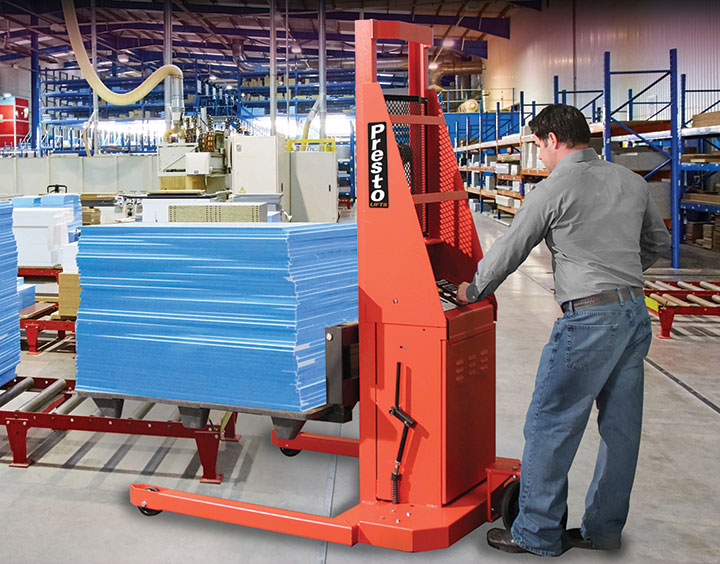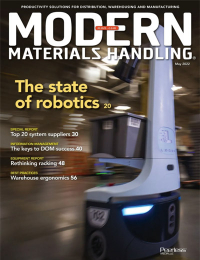Lightening loads with warehouse ergonomics
How companies are using ergonomics to retain employees, minimize musculoskeletal injuries and get a bit more output out of every shift.

In a business environment where jobless claims are the lowest they’ve been in 53 years, the Great Resignation is still in full effect, and the national unemployment rate was 3.6% in March, keeping workers comfortable, safe and productive has become table stakes for most companies. For the warehousing, distribution and logistics sectors—where long shifts and heavy lifting are fairly common—ergonomics are especially important.
An applied science concerned with designing and arranging things people use so the people and things interact most efficiently and safely, ergonomics not only helps reduce (or even eliminate) awkward posture and other stresses on the musculoskeletal system, but it also helps spread a message that employers truly care about their employees’ wellbeing—both in and out of work. This is an important win in a world where labor is hard to come by and, in some cases, even more difficult to retain.
Making a workplace ergonomically correct can directly impact productivity and throughput while helping workers avoid the emergency room, where more than 47,000 workers in private industry are treated for musculoskeletal disorders (or ergonomic injuries) every year, according to the Bureau of Labor Statistics (BLS). Ergonomic injuries account for one out of every three missed workdays, BLS adds, and employees take a median of 11 days off annually due to ergonomic-related injuries.
Rethinking ergonomics
The ongoing pandemic impacts and the fact that job candidates have many opportunities to choose from right now are pushing companies to rethink their approach to ergonomics and consider what they can be doing better. At this year’s Applied Ergonomics Conference, Southworth Products’ national sales manager Pete Horne says these and other trends were discussed in detail.

“Employers want to know what they can do to upgrade their workspaces and retain employees,” says Horne, who is also seeing a greater overall emphasis on workplace health and safety, and on minimizing workforce injuries.
“Obviously increases in medical and insurance costs are becoming more and more a factor when people suffer [musculoskeletal] injuries on the job,” says Horne. “These are just some of the key reasons more companies are coming to us for help with ergonomic design.” For example, he says, organizations are seeking more flexible accessories that can be easily moved around or adjusted to accommodate a left-handed, right-handed, short or tall person.
“We’re seeing an increase in sales of motorized height, adjustable benches,” Horne says. In response, Southworth introduced a new motorized light industrial bench in 2021. The product fills the gap between basic office furniture and heavy-duty motor tables. “There was really nothing in between,” Horne explains. “For some, the industrial-level benches were too expensive to buy, but this light industrial bench is about 50% of the price of our standard motor bench.”
Horne says companies are also asking for modular options that allow them to scale up quickly when their e-commerce order volume demands it. Being able to make quick adjustments on the fly helps operators fit the equipment to their own needs, requirements and stature—and not the other way around. For example, someone may want to raise a bench for packing small boxes but then quickly lower it to accommodate larger boxes. Right now, Southworth’s production line includes a quick-adjuster bench that requires one pull of a bar (versus having to hold down a button while the bench moves up or down) to get it positioned as desired.
Not everything is going to be a robot
The idea that robots will eventually be able to handle all of the heavy lifting, twisting and maneuvering in the warehouse is probably valid, but at least right now companies still need equipment that helps human workers tackle these and other tasks.
“Not everything is going to be a robot,” says Rick daSilva, national sales manager at Presto Lifts, which makes ergonomic pallet positioning equipment that allows employees to move pallets up and down and turn them instead of having to walk around them. The latter helps reduce worker fatigue.
“There are fewer workers to choose from, so companies have to take care of the people who are working for them, or risk employees burning out and leaving,” says daSilva, who sees ergonomic pallet positioners as a good option for companies that are having to wait 26 to 52 weeks (or longer) for new forklift orders to arrive. “We have pallet stackers that can ship within a few weeks,” says daSilva, “and that help companies better balance their existing lift truck fleets with their increased throughput.”
As the labor shortage continues, Dan Smith, national sales manager at Treston, says he’s seen an exponential increase in the number of companies that want their operations to be as ergonomic as possible. The trend isn’t limited to warehouses and DCs either.
“I’m hearing it from everyone right now,” says Smith. “This isn’t just a manufacturing, distribution or warehousing issue. It’s also retailers, fast food restaurants, you name it.”
Specific to the warehouse setting, Smith says the high volume of e-commerce orders can make jobs particularly strenuous and exhausting—so much so that in some cases, a brand new employee on his or her first day on the job will punch out for lunch and never come back. “If they don’t like the job, they’re gone,” he says.
To help minimize these occurrences, Smith says companies are looking for equipment that requires less training and that helps take some or all of the load off of the individual worker. A lift table that can be adjusted to fit a specific employee, and that doesn’t take long to learn how to use, can positively impact worker retention. He says Treston’s units include turntables that support easier stacking and unstacking from conveyors, and that help speed up the loading and unloading process without putting additional strain on the worker.

Like daSilva, Smith says that the day when robots and automation handle the heavy lifting, turning, and repositioning for employees could still be far off, and particularly for those companies that can’t justify a large investment in these advanced technologies. Ergonomic equipment helps to fill that gap on a more accessible and affordable level while supporting higher throughput rates and levels of safety.
“For companies that don’t have the budgets for expensive automation, ergonomic lift tables, cranes and other equipment definitely come into play,” says Smith. “Full automation is a realistic goal, but for now we still have customers that tell us that, until automation does it all, our machines are the best fit for their operations.”
Lightening their loads
Once a futuristic vision of what warehouse work could look like, the ergonomic exoskeleton has since begun to make its way into facilities nationwide. These suit-like structures are a mechanical extension of an operator, often wearable and used for assistance in a range of motion.
It is often used as an aid to walking, for example. It can be battery-powered or not; using a small motor or other lift assist technology, it can support muscles used for lifting, providing a push that may avoid pushing a worker’s body past its limits.
Matthew Marino, director of ergonomics and human performance at HeroWear, has been working with exoskeletons since 2015 and says the products have come a long way since then, both in terms of material advancements and adoption.
“People continue to hurt their backs and employee turnover has created a revolving door for many companies,” says Marino. “If they can go down the street and work for a different company for a buck or two more, they’re probably going to do that.”
The company that wants to slow that revolving door and gain a competitive edge in the workplace while managing a higher volume of smaller, e-commerce orders is likely investing in more ergonomics. “Unfortunately, productivity doesn’t necessarily go hand-in-hand with a healthy back,” says Marino, who sees exosuits like HeroWear’s Apex playing an increasingly important role in the modern warehouse.
“If people are less tired over the course of the day, week or month, or for those last couple of hours in a shift, companies can have an additional ‘boost’ of productivity during that period without workers really noticing it,” says Marino. “They can just do their jobs like they normally would, but while they’re less tired and able to lift a couple more boxes or move a few more products.”
More to come
To companies that are shopping for ergonomic equipment and furniture this year, Horne says the best first step is to nail down your process first and then design a workstation around it. Using a software platform like VelocityEHS, you can capture a video of an employee handling the work process and upload it for a quick ergonomics assessment.
“It points out the potential problem—overexertion, overreaching—areas by flashing that part of the body red,” says Horne. “Then it helps determine what design changes are needed in the workspace.”
Looking ahead, daSilva expects the ergonomics conversation to begin including more vertical-height activities, as well as the need to climb steps to get to mezzanine levels and order-pick platforms. The trend is being driven by workers’ own height variations and the fact that more DCs are trying to make use of vertical space.
“We’re seeing increased demand for what we call ‘work access lifts,’ where the worker steps on a lift at ground level and is raised and lowered to perform a task rather than using a ladder,” he describes. “This is a segment that will continue to grow into the future.”

Article Topics
Ergonomics News & Resources
Shift Robotics demonstrates warehouse Moonwalkers HeroWear demonstrates a back-assist exosuit SIGI announces key leadership promotions Autoquip Corporation acquires German company J.A. Becker & Söhne Packaging Corner: Be open to change Monorail Manufacturers Association celebrates 90 years of monorail best practices Treston acquires business assets of IAC Industries More ErgonomicsLatest in Materials Handling
Registration open for Pack Expo International 2024 Walmart chooses Swisslog AS/RS and software for third milk processing facility NetLogistik partners with Vuzix subsidiary Moviynt to offer mobility solutions for warehouses Materials Handling Robotics: The new world of heterogeneous robotic integration BSLBATT is looking for new distributors and resellers worldwide Lucas Watson appointed CSO for Körber’s Parcel Logistics business in North America Hyster recognizes Dealers of Distinction for 2023 More Materials HandlingAbout the Author
Subscribe to Materials Handling Magazine

Find out what the world's most innovative companies are doing to improve productivity in their plants and distribution centers.
Start your FREE subscription today.
April 2024 Modern Materials Handling

Latest Resources











